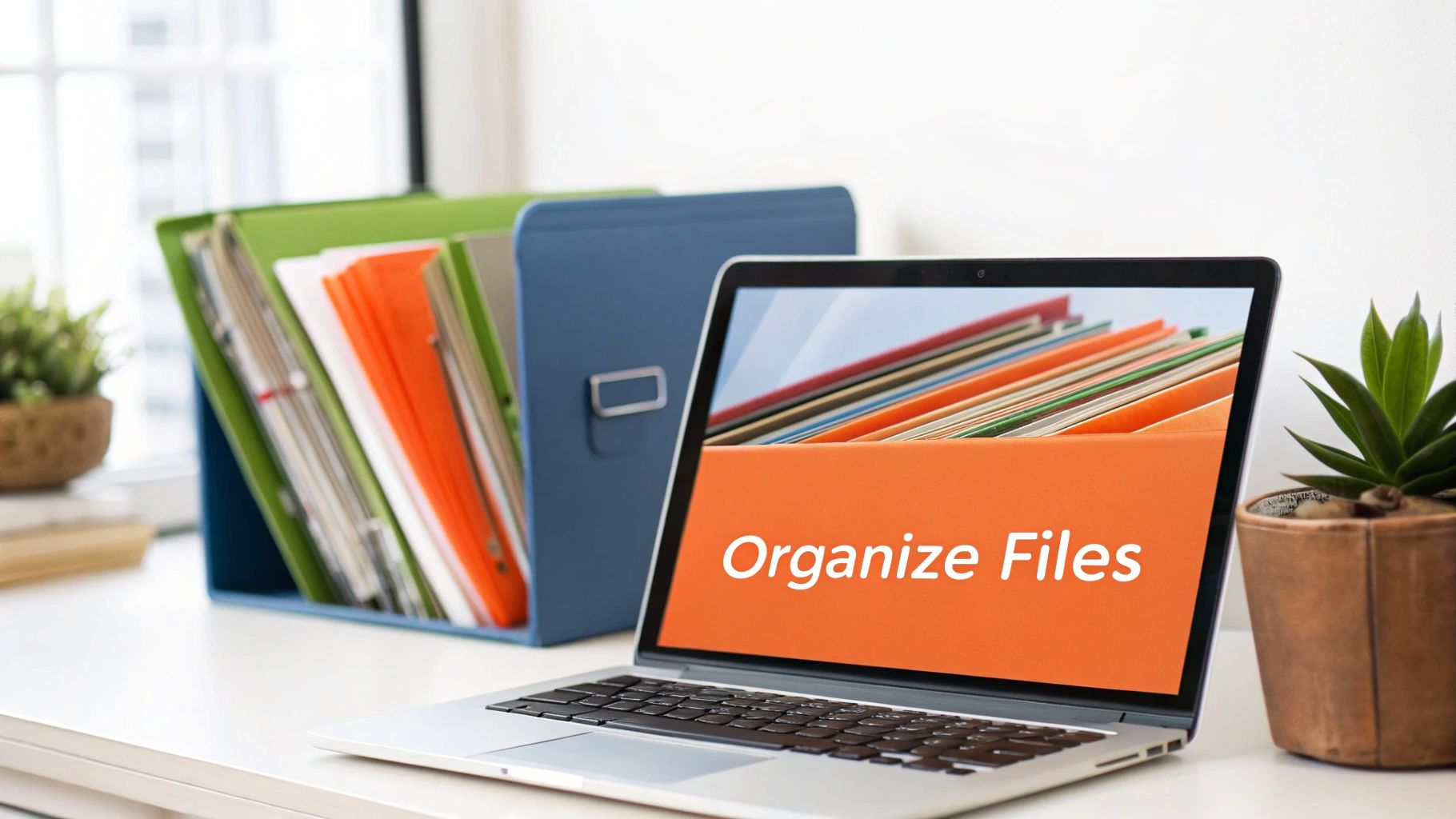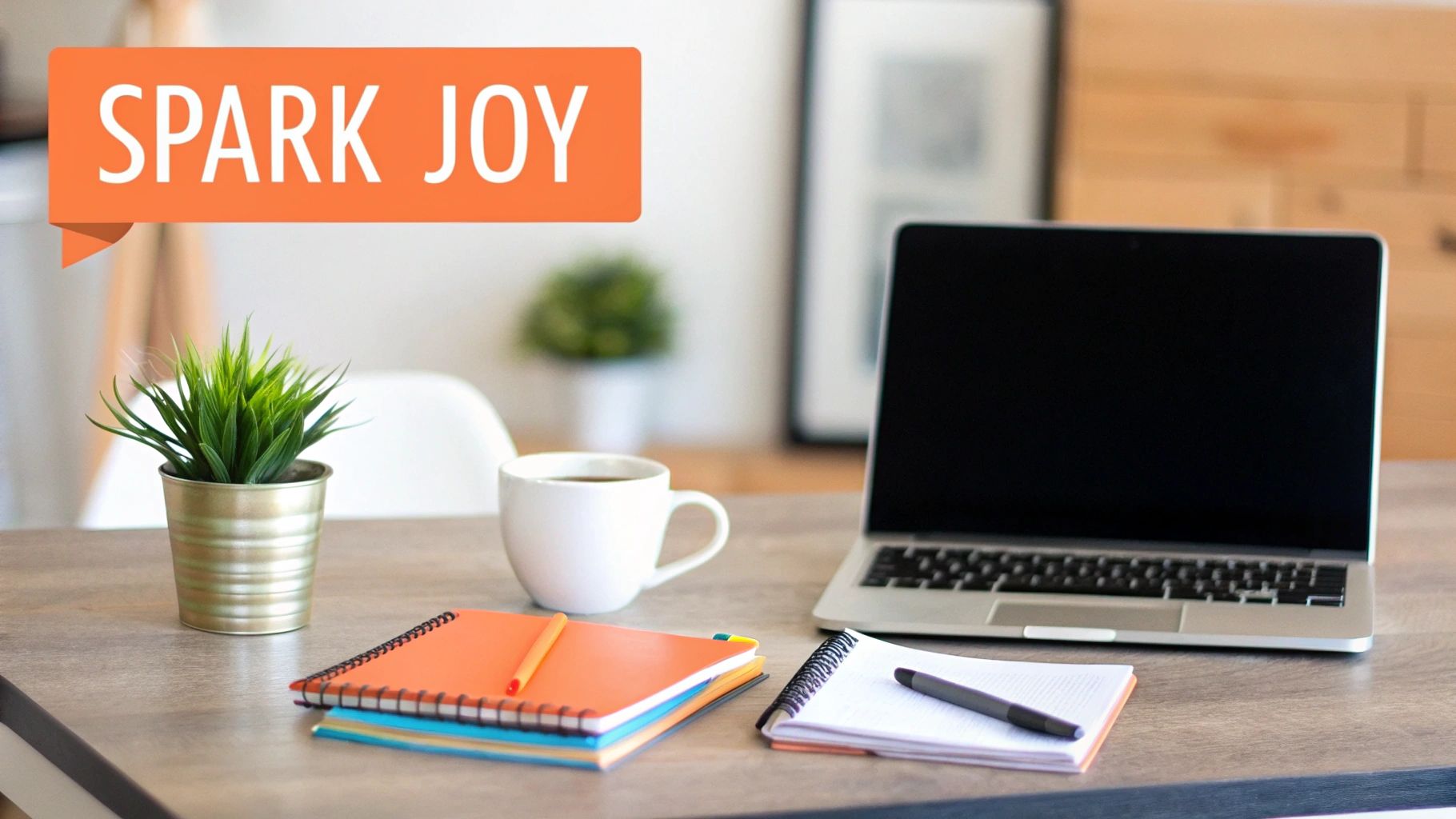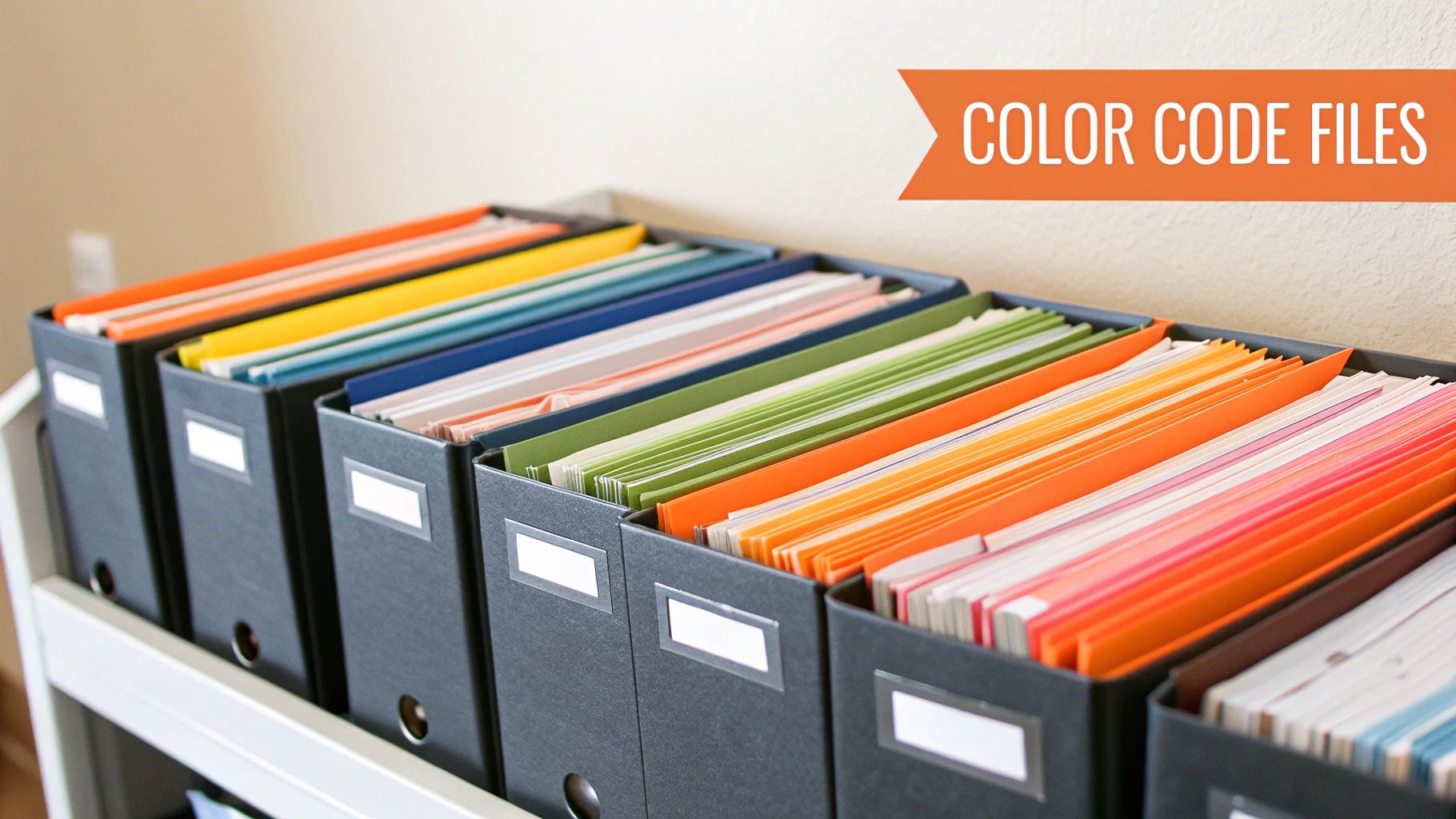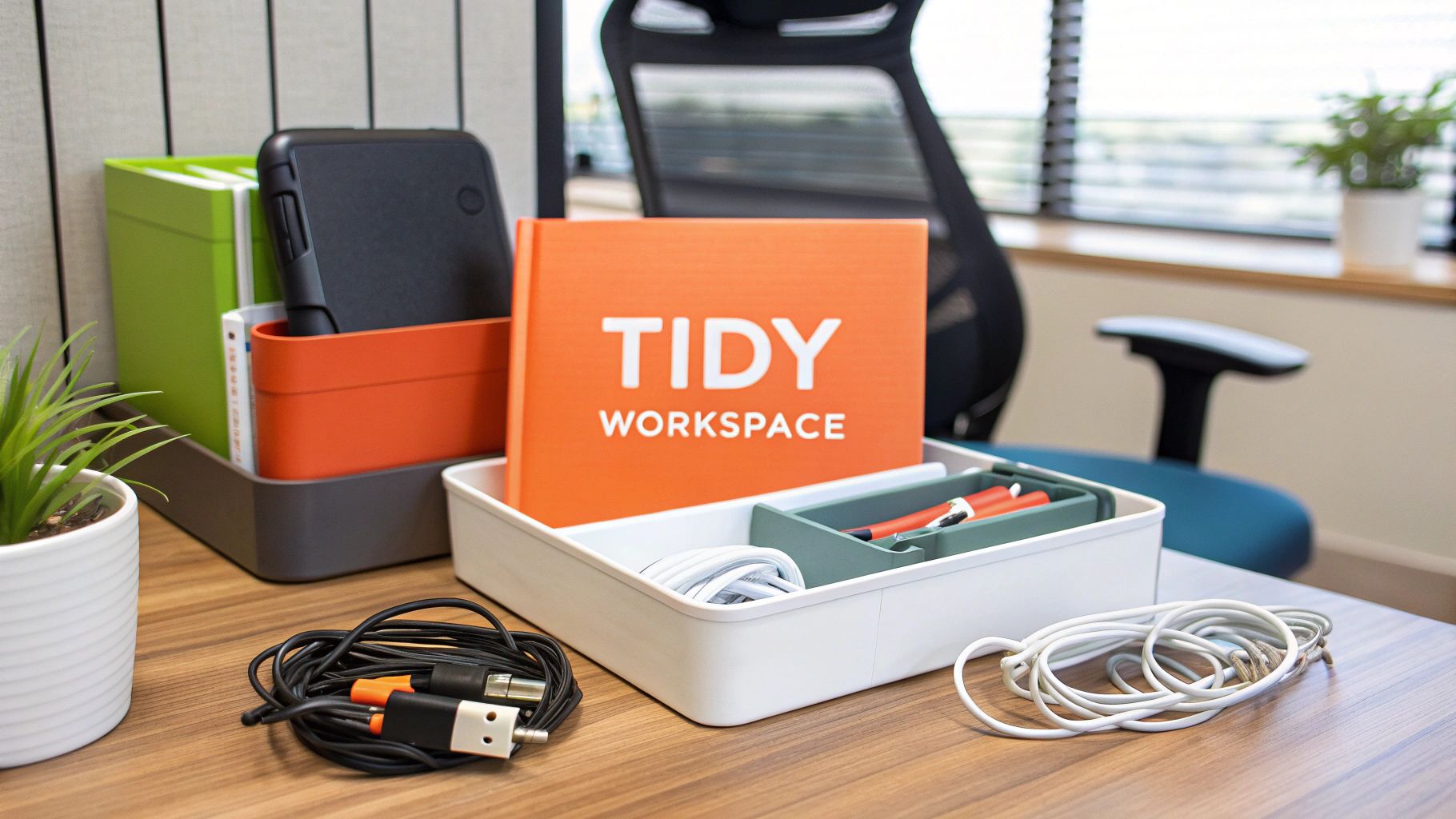An organised office is more than just a tidy desk; it's the foundation for productivity, clarity, and reduced stress. A cluttered workspace can lead to lost time, misplaced documents, and a constant feeling of being overwhelmed. However, implementing a smart system can transform your environment from chaotic to calm and controlled. This guide moves beyond generic advice to offer specific, actionable office organisation ideas that address both your physical and digital spaces.
We will explore ten proven methods designed to create a streamlined workflow. You'll learn how to implement powerful systems like the KonMari Method for your desk, the 5S methodology for workplace efficiency, and the Getting Things Done (GTD) framework for task management. From practical wall-mounted storage to colour-coded filing systems, each idea provides a clear path to a more orderly and functional workspace.
A well-organised desk clears physical clutter, but to truly unlock your peak performance, you must also cultivate mental order. For techniques on improving concentration once your space is set, you can learn how to master how to focus at work. Let's explore how you can systematise your space for ultimate efficiency and peace of mind.
1. Digital File Organisation System
Before tackling the physical clutter on your desk, address the digital chaos on your computer. A digital file organisation system establishes a clear, logical hierarchy for all your documents, spreadsheets, and presentations. This approach relies on standardised folder structures and consistent naming conventions, making information instantly searchable and accessible across all your devices.

This method eliminates wasted time hunting for lost files and ensures everyone on your team can find what they need, a core principle in modern office organisation ideas. Large corporations use platforms like SharePoint, while remote teams often rely on Google Workspace to keep their shared projects in order.
How to Implement a Digital System
To streamline your digital files and achieve peak efficiency, consider implementing a robust document management system. Start with these simple, actionable steps:
- Use Date Prefixes: Begin filenames with the date in a YYYY-MM-DD format (e.g.,
2024-08-21_Client-Report.pdf) to automatically sort files chronologically. - Create Folder Templates: Design a master folder template for new projects or clients (e.g., a "New Client" folder containing sub-folders for "Contracts," "Invoices," and "Meeting Notes") to ensure consistency.
- Schedule Cleanups: Set a recurring calendar reminder each month or quarter to archive old projects and delete redundant files.
- Be Descriptive: Use clear, concise file names that describe the content without being overly long. For example, use "Q3-Marketing-Budget-Final" instead of just "Budget".
2. Marie Kondo's KonMari Method for Offices
The KonMari Method, popularised by tidying expert Marie Kondo, can be adapted from the home to the workplace. This approach to office organisation ideas encourages you to keep only items that "spark joy" or serve a clear, essential professional purpose. By decluttering by category (like books, papers, or stationery) rather than by location, you create a more intentional and mindful workspace that supports focus and productivity.

This philosophy is not just for individuals; entire organisations have adopted its principles to foster more positive and efficient environments. The method's focus on mindfulness and purpose aligns perfectly with modern corporate wellness programs, helping employees reduce stress and gain clarity. The resulting minimalist aesthetic often influences office furniture arrangement ideas by promoting open, uncluttered layouts.
How to Implement the KonMari Method
To bring the KonMari philosophy to your desk and revolutionise your workday, start with these focused steps. The goal is to create a space where every item has a designated home.
- Tackle Papers First: Gather every single piece of paper from your desk, drawers, and shelves. Sort them into three piles: must keep (e.g., contracts), action required, and discard.
- Designate a Home: Once you've decided what to keep, assign a permanent spot for every item. Use drawer dividers and small containers to keep stationery and supplies neatly separated.
- Embrace Vertical Storage: Instead of stacking documents flat, file them vertically. This makes them easier to see and retrieve, preventing forgotten papers from piling up.
- Schedule a "Tidy-Up": Just like a digital cleanup, set aside a few minutes at the end of each day or week to return items to their designated homes.
3. The Inbox Zero Email Management System
Just as a clear desk fosters productivity, an empty inbox reduces digital stress and sharpens focus. The Inbox Zero system is a methodical approach to email management, popularised by productivity expert Merlin Mann. It treats your inbox not as a to-do list but as a processing station, ensuring emails don’t accumulate and cause overwhelm.
This method centres on five core actions for every email: delete, delegate, respond, defer, or do. By processing emails immediately, you prevent them from becoming a source of distraction. Tech executives managing hundreds of daily messages and customer service teams with structured workflows use this system to maintain control and efficiency, making it one of the most powerful digital office organisation ideas available.
How to Implement Inbox Zero
To reclaim your inbox and prevent email overload, you need a disciplined process. Start with these simple, actionable steps:
- Schedule Email Time: Designate specific blocks in your day for processing emails, rather than checking them constantly. This prevents continuous interruptions to your workflow.
- Use the Two-Minute Rule: If an email requires a response that will take two minutes or less, answer it immediately. This clears simple tasks from your queue instantly.
- Automate with Filters and Rules: Set up filters to automatically sort incoming mail. For example, direct newsletters to a "Reading" folder or non-urgent notifications to be archived.
- Create Template Responses: For frequent inquiries, have pre-written templates ready. This saves significant time and ensures consistent communication.
- Aggressively Unsubscribe: Be ruthless about unsubscribing from mailing lists that no longer provide value. This drastically reduces the volume of incoming mail needing your attention.
4. The 5S Workplace Organisation Methodology
Originating from Japan's manufacturing sector, the 5S methodology is a powerful system for creating and maintaining a highly organised, clean, and efficient workspace. This philosophy focuses on a five-step process: Sort (Seiri), Set in Order (Seiton), Shine (Seiso), Standardise (Seiketsu), and Sustain (Shitsuke). While popularised by the Toyota Production System, its principles are now widely adapted in office settings to boost productivity and minimise waste.
Successful implementation can be seen in diverse environments, from Honda's administrative departments streamlining their workflows to hospitals organising critical medical supplies and records. This method provides a clear framework for practical office organisation ideas, transforming chaotic spaces into models of efficiency.
How to Implement the 5S System
To integrate this lean methodology, focus on applying its core principles sequentially to your physical and digital workspaces. Start small and build momentum with these actionable steps:
- Start with a Pilot Area: Choose one small area, like a single filing cabinet or a shared supply cupboard, to test the 5S process before a full-scale rollout.
- Use Visual Management: Employ colour-coding for files, labels for drawers, and designated outlines for equipment (e.g., tape on a desk showing where the keyboard belongs) to make it obvious where things go.
- Involve Your Team: Encourage employees to participate in organising their own areas. This fosters a sense of ownership and ensures the system is practical for daily use.
- Conduct Regular Audits: Use a simple checklist or scorecard to regularly review workspaces against 5S standards. This helps maintain the system and identify areas for improvement.
- Celebrate Success: Publicly acknowledge team efforts and improvements to reinforce positive habits and maintain motivation for the long term.
5. Modular Desk Organisation Systems
A static desk setup doesn't work for everyone, which is why modular desk organisation systems offer a flexible and personalised solution. These systems use interchangeable components like adjustable dividers, stackable containers, and customisable inserts that can be reconfigured as your needs change. This approach allows you to build a setup that perfectly matches your workflow and available space.
This method is one of the most adaptable office organisation ideas, preventing you from being locked into a single layout. Brands like IKEA with its SKÅDIS pegboard system and The Container Store with its Elfa products have popularised this concept, offering everything from basic trays to comprehensive, integrated solutions for any desk.
How to Implement a Modular System
Building an effective modular system is about tailoring it to your specific tasks and tools. To get started, you can explore various home office setup ideas for inspiration. Follow these steps for a successful implementation:
- Assess Your Needs: Before buying, make a list of the items you use most frequently (pens, notebooks, chargers, etc.) to determine which components you require.
- Start Small and Expand: Begin with a few essential components like a tray or a pen holder. You can gradually add more modules as you understand your workflow better.
- Measure Your Space: Carefully measure your desk area to ensure the components you choose will fit perfectly without creating more clutter.
- Consider Weight Limits: If you plan on using stackable containers or wall-mounted shelves, check the weight capacity to avoid accidents or damage.
- Choose Neutral Colours: Opt for neutral tones like white, grey, or black for your core components. This ensures long-term flexibility and a cohesive look even if you add new pieces later.
6. Color-Coded Filing and Organisation System
A colour-coded filing and organisation system uses visual cues to categorise documents, projects, or priorities. This powerful method leverages the brain's natural ability to process colours faster than text, making it significantly quicker to locate and sort physical or digital materials. By assigning a specific colour to a category, you create an intuitive structure that is easy to understand at a glance.
This approach is one of the most effective office organisation ideas because it simplifies complex information streams. For instance, medical offices often use colours to distinguish between insurance providers, while law firms might assign a colour to each practice area. It provides an immediate visual shortcut, reducing search time and minimising the risk of misfiling critical documents.
How to Implement a Colour-Coded System
Implementing a visual system is straightforward and highly effective for boosting efficiency. To get started, apply these practical steps:
- Create a Colour Legend: Develop a master key that clearly defines what each colour represents (e.g., Red for Urgent, Blue for Client A, Green for Invoices). Post this legend in a visible location for all team members to see.
- Limit Your Palette: To avoid confusion, stick to a manageable number of distinct colours, ideally between five and seven. Too many shades can become counterproductive and difficult to remember.
- Maintain Consistency: Apply the same colour scheme across all platforms, including physical folders, digital file icons, calendar events, and project management software, to create a unified system.
- Train Your Team: Ensure everyone understands the system. A brief training session and a readily available colour key are crucial for successful team-wide adoption and consistency.
7. The Getting Things Done (GTD) Workspace Setup
Moving beyond simple tidiness, the Getting Things Done (GTD) method organises your workspace around a workflow for managing tasks. Popularised by productivity consultant David Allen, this approach transforms your desk into a command centre for capturing, clarifying, and engaging with your commitments. It focuses on creating dedicated physical and digital spaces for your "inbox," reference materials, and project support files to achieve stress-free productivity.

This system is one of the most comprehensive office organisation ideas, ideal for executives and entrepreneurs managing complex responsibilities. The goal is to get tasks out of your head and into a trusted system, freeing up mental space for focused work. For those looking to fully implement this powerful framework, we recommend exploring The Ultimate Guide to Getting Things Done (GTD).
How to Implement a GTD Workspace
To set up your desk for GTD, you need to create zones for each stage of the workflow. For more inspiration on arranging these zones, explore these desk setup ideas.
- Designate a Capture Tool: Use a physical in-tray or a digital app as a single place to collect all incoming tasks, ideas, and notes.
- Separate Action and Reference: Keep files you need to act on separate from materials you only need for reference. Use labelled folders or digital tags.
- Maintain a "Next Actions" List: Your to-do list should only contain the very next physical action required to move a project forward.
- Conduct a Weekly Review: Schedule time each week to process your inbox, review your project lists, and clear your mind to ensure the system remains current and reliable.
8. Wall-Mounted Vertical Storage Solutions
When desk and floor space are at a premium, the best direction to go is up. Wall-mounted vertical storage solutions transform empty walls into functional organising hubs for supplies, documents, and equipment. Systems like pegboards, wall pockets, and modular shelving keep essential items visible and within arm's reach, making them a cornerstone of modern office organisation ideas.
This approach is perfect for small or home offices where every square metre counts. For example, creative agencies often use wall grids to display project materials, while medical offices rely on wall pockets to keep patient charts organised and accessible. These solutions reduce surface clutter, creating a more focused and productive workspace.
How to Implement Vertical Storage
To effectively utilise your wall space, you need a clear plan. While open shelving is great for accessible items, sensitive documents or valuable equipment may require more secure options. A lockable storage cabinet can complement your vertical system by protecting confidential information.
- Plan Your Layout: Before drilling any holes, map out where each element will go. Use painter's tape to visualise the placement of shelves or pegboards.
- Group Similar Items: Store related supplies together, such as placing all your pens, markers, and highlighters in one wall-mounted container for a visually tidy look.
- Ensure Level Installation: Use a spirit level during installation to ensure your shelves and boards are perfectly straight. A crooked shelf is both distracting and unstable.
- Consider Accessibility: Position frequently used items at eye level or within easy reach. Reserve higher, less accessible spots for archival files or rarely used equipment.
9. Digital-Physical Hybrid Organisation System
For offices that can't go fully paperless, a hybrid organisation system bridges the gap between physical items and digital information. This integrated approach uses technology like QR codes or digital catalogues to link tangible assets, like file boxes or equipment, to a searchable online database. It provides the security of physical storage while offering the speed and convenience of digital tracking.
This method is one of the most powerful office organisation ideas for sectors that manage extensive physical records. For example, a law firm can place a QR code on a box of client files; scanning it reveals a digital inventory of its contents, its location, and its access history. This system ensures physical items are never truly lost, just a quick search away.
How to Implement a Hybrid System
To effectively merge your physical and digital worlds, you need a clear and consistent strategy. A clean workspace, free of tangled cords, is foundational to this organised approach. You can get tips on tidying up your tech infrastructure by learning about under-desk cable management.
- Start Small: Begin by cataloguing high-value or frequently accessed items first to test and refine your process.
- Use Consistent Naming: Ensure your naming conventions are identical across both the physical labels and the digital database for seamless searching.
- Create a Digital Twin: For each physical item or container, create a corresponding digital entry with details like contents, location, and check-out status.
- Train Your Team: Ensure everyone understands how to use the system, from scanning codes to updating the digital log, to maintain its accuracy.
10. The One-Touch Rule Organisation System
To combat the piles of paper and overflowing in-trays, adopt the One-Touch Rule, an efficiency-focused principle for handling items only once. When you pick up a document, email, or task, you must decide its fate immediately: act on it, file it, delegate it, or discard it. This system prevents items from entering a "pending" limbo, which is a major source of office clutter.
This method is a cornerstone of lean office methodology and is one of the most powerful office organisation ideas for boosting productivity. Administrative assistants use it to process incoming mail instantly, while project managers apply it to team requests to keep workflows moving without delay. By eliminating re-handling, you free up valuable time and mental energy.
How to Implement the One-Touch Rule
Making immediate decisions requires a clear framework. Start by integrating this powerful habit into your daily routine with these practical steps:
- Define Action Categories: Clearly establish what "act," "file," "delegate," and "discard" mean for your role. For example, "act" might mean replying to an email, while "file" means saving it to a specific project folder.
- Prepare Your Tools: Ensure your filing system, recycling bin, and task management software are ready and accessible. If you have to search for a folder, the system breaks down.
- Set Time Limits: Give yourself a strict but realistic timeframe, like two minutes, to make a decision on any single item. This encourages decisiveness and prevents overthinking.
- Practise with Low-Stakes Items: Build your confidence by first applying the rule to less critical items, such as newsletters or general office memos, before tackling complex client reports.
Office Organization Ideas Comparison Table
Building Your Foundation for Lasting Organisation
We've explored a wide spectrum of powerful office organization ideas, from the digital precision of Inbox Zero and hybrid filing systems to the physical order of the 5S methodology and vertical storage. Each approach offers a unique pathway to a more streamlined, productive, and less stressful workspace. Whether you're drawn to the decisive minimalism of the KonMari Method, the systematic task management of GTD, or the simple efficiency of a colour-coded system, the core principle remains the same: a tidy environment fosters a clear mind.
The true goal is not just to clean your desk once but to build a sustainable system that works for you. An organised office isn't about achieving an unrealistic state of perfection; it's about reducing the daily friction that drains your energy and focus. By implementing strategies like the One-Touch Rule, you make it easier to maintain order than to let clutter build up, transforming organisation from a chore into a natural part of your workflow.
Weaving Your Personal System
The most effective organisational strategy is often not one-size-fits-all but a custom blend of several techniques.
- You might pair the Getting Things Done (GTD) methodology for task management with a 5S approach to your physical desk layout.
- A digital-physical hybrid system could be enhanced with colour-coding to create instant visual recognition for urgent projects.
- The One-Touch Rule can be applied to both your physical inbox and your digital one, complementing an Inbox Zero strategy perfectly.
The key is to experiment. Try one or two of these ideas for a week and see how they feel. Notice where you struggle and where you succeed. The best system for your office is one that aligns with your natural habits and the specific demands of your job.
The True Cornerstone of Productivity
While these organisational frameworks are vital, they address only one part of the productivity equation. True, lasting focus is built upon a foundation of physical well-being. You can have the most meticulously organised desk in the world, but if you're constantly shifting to alleviate back pain or neck strain, your concentration will inevitably suffer. The most critical piece of your workspace puzzle is the one you occupy all day: your chair.
Investing in a high-quality, ergonomic chair is not a luxury; it is a fundamental component of a functional and productive office. It supports your body, which in turn supports your ability to think, create, and perform at your best.
This is where the principles of organisation and ergonomics intersect. By creating a workspace that is both systematically organised and physically supportive, you construct a holistic environment designed for peak performance. You eliminate mental clutter with smart systems and physical discomfort with proper ergonomic support, freeing up your cognitive resources to tackle your most important work with clarity and confidence. The ultimate goal of all these office organization ideas is to build a space that truly works for you, in every sense of the word.
Ready to build the ultimate foundation for your organised workspace? An ergonomic chair is the centrepiece of a productive and comfortable office. Explore the AFRDI-approved range at Pago International and discover how the right support can transform your workday. Visit Pago International to find the perfect chair for your newly organised space.


